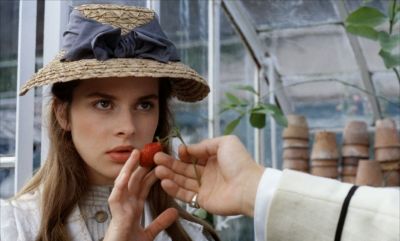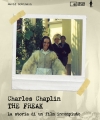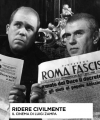
TESS
(Gb/1979) R.: Roman Polanski. D.: 171'. V. inglese Digitale
Restaurato da Pathé
Serata promossa da Banca Popolare dell'Emilia Romagna
La copia restaurata è stata realizzata digitalizzando il negativo in 4K. I test preliminari in 2K e 4K avevano rivelato che solo la digitalizzazione in 4K sarebbe stata in grado di riprodurre i contorni delle immagini, i toni raffinati degli incarnati e il bagliore tenue e meravigliosamente diffuso dei film di quegli anni, ottenuto dai due direttori della fotografia, Geoffrey Unsworth e Ghislain Cloquet, grazie all'uso di filtri. Il restauro del suono è stato condotto da L.E. Diapason. Tess è stato uno dei primi film a usare il Dolby Stereo, formato che avrebbe rivoluzionato il cinema con l'introduzione del sonoro multicanale nella maggioranza delle sale cinematografiche. Sebbene sia probabile che il suono sia stato mixato con attrezzature adattate alla meglio al sistema multicanale, la colonna sonora del film esplorava già le possibilità offerte dal formato, in particolare nel sontuoso trattamento delle musiche e nel lavoro condotto sull'atmosfera che offrono una rara qualità e profondità.
"Sono stato molto influenzato dal surrealismo e dal teatro dell'assurdo" ha dichiarato Polanski. "Ma adesso che il mondo è diventato assurdo e quasi surreale voglio tornare alla semplicità e all'essenzialità delle relazioni umane. [...] Tess è soprattutto una grande storia d'amore [...]. Le vicissitudini di Tess corrispondono all'ossatura del melodramma vittoriano: sedotta, resta incinta e dà alla luce un bambino che muore ancora in fasce, sposa un giovane che poi l'abbandona e finisce sul patibolo per l'omicidio del suo seduttore. Ma la carne con cui Hardy ricopre quell'ossatura è stupefacente. Lega la ragazza al ritmo della natura, all'interno di una società vittoriana in conflitto con tutto ciò che è spontaneo e naturale. [...] Tess è rigenerazione e continuità, ma l'epoca e la società in cui vive sono scardinate. Contrapponendo Tess alla madre, Hardy lo sottolinea magnificamente. [...] Il contrasto sta tutto lì. [...] La madre appartiene al passato e Tess al presente, alla modernità, come voi e me. È la prima eroina autenticamente moderna. [...] Tess segna l'inizio di una nuova fase. Come ho già detto, è il film della mia maturità. Se la gente ha un'idea così limitata del mio stile e dei miei interessi da non riuscire ad accettare qualcosa di diverso, mi dispiace. Nel cinema capita che i registi vengano incasellati come succede con gli attori. Sono certo che a Cannes il film farà discutere". coproduzione franco-britannica, è il primo film sonoro tratto dal romanzo di Hardy. È stato preceduto da un muto del 1924 con Blanche Sweet e Conrad Nagel. I diritti di sfruttamento cinematografico rimasero in possesso di David O. Selznick per molti anni (per Tess si pensava a Jennifer Jones). [...] Polanski scoprì il libro qualche anno fa grazie alla moglie Sharon Tate, che era stata proposta per il ruolo principale. [...] Chi doveva interpretare Tess? Il film prese una direzione interessante quando il ruolo dell'eroina bella e sfortunata di Hardy andò a una giovane attrice tedesca, Nastassja Kinski [...]. "Quando l'ho conosciuta" ricorda Polanski "Nastassja aveva quindici anni, ma era già una donna. Una donna e una bambina nello stesso tempo. È ancora così, e naturalmente questa qualità è perfetta per Tess. [...] Tess è stato realizzato con una gran dose di improvvisazione. Abbiamo girato molto al crepuscolo o in penombra, con troupe, macchina da presa e attori che si affannavano per sfruttare la luce in un dato momento e in un dato luogo. [...] Con i film in costume si corrono rischi di quel tipo. [...] La bellezza delle immagini dovrebbe essere solo un di più, un bonus. La gente non va al cinema per vedere un album di belle fotografie. Ci va per provare qualcosa. [...] Nell'arte quello che conta è l'emozione. [...] L'arte deve coinvolgere, e se non lo fa non lascia un'impressione durevole. Ci sono tanti modi per coinvolgere il pubblico, per farlo piangere, ridere, avere paura. Con Tess abbiamo a disposizione del materiale così forte da non doverci preoccupare delle belle immagini. La storia è appassionante, la ragazza commovente e il film ricco di emozioni universali. Va ricordato che Tess [...] è una donna pura. Era questo il sottotitolo del romanzo di Hardy. Tess infrange i codici morali vittoriani per ubbidire alla legge naturale, alla natura, la sua natura. Il libro parla di questo. Il film è un'accusa all'ipocrisia e all'ingiustizia di quella società, e più in generale di tutte le società rigide e repressive".
Roman Polanski, in Harlan Kennedy, "Tess": Polanski in a Hard Country, "American Film", vol. 5, n. 1, ottobre 1979
The restored print was created by digitalizing the negative image in 4K. Preliminary tests in 2K and 4K revealed that only 4K digitalization would be able to translate the contours of the image, the refined skin tones and the light and wonderfully diffuse glow of films from the time, obtained through the filters used by the film's two directors of photography, Geoffrey Unsworth and Ghislain Cloquet. Sound restoration was carried out by L.E. Diapason. Tess was one of the first films to use Dolby Stereo, the format that would revolutionize cinema by introducing multichannel sound to the majority of theaters. Although it is likely that the sound was mixed using equipment poorly adapted to multichannel sound, the film's soundtrack was already exploring the possibilities offered by the format, mainly in terms of the lavish treatment of music and the extraordinary work carried out on the atmosphere which offers a rare depth and quality.
"I have been influenced a great deal by surrealism and the theater of the absurd", Polanski said. "But now that the world itself has become absurd and almost surreal, I want to go back to the simplicity and essence of human relationships. [...] Tess is above all a great love story [...] What happens to Tess in the story is very much the raw-bones of Victorian melodrama: she is seduced when young, bears a child who dies, is deserted by the man she later marries, and finally is sent to the gallows for the murder of her seducer. But the flesh Hardy puts on those bones is astonishing. He links the girl to the rhythm of nature, within a Victorian society at odds with everything spontaneous and natural. [...] Tess is regeneration and continuance. But the social times she lives in are out of joint. By contrasting her with her mother, Hardy points this up marvelously. [...] The contrast is all there [...]. The mother belongs to the past. Tess belongs to the present, to the modern age, to you and me. She is the first truly modern heroine. [...] Tess is a new departure. It is, as I have said, the film of my mature years. I shall be sorry if people have such a limited idea of what my style as a director is like - and my preoccupations - that they cannot accept something different from me. In the cinema, directors can be typecast as well as actors. The point will undoubtedly be raised in Cannes". Tess, a French-English coproduction, will mark the first time that Hardy's novel has talked on the screen. It was filmed once - a silent version in 1924 starring Blanche Sweet and Conrad Nagel - and after that David O. Selznick held the movie rights for many years (with Jennifer Jones in mind for Tess). [...] Polanski discovered the book some years ago through his wife, Sharon Tate, who had been suggested for the role of Tess. [...] Who was to play Tess? The production took an intriguing turn when the role of Hardy's doomed and beautiful heroine went to a young German actress: Nastassia Kinski [...]. "When I met Nastassia", Polanski recalls, "she was fifteen, but she was a woman. Woman and child at the same time. She still has this quality, and that is perfect, of course, for Tess. [...]On Tess we were really very... improvisatory. We did a lot of filming in the twilight or half-light, and that meant rushing about with the crew, camera, and actors to catch the light at a certain moment in a certain place". [...] "There are dangers like that with a period film [...]. The beautiful images should be only an extra; they must be the bonus. People don't go to the cinema to see a collection of beautiful photographs. They go to experience something. The emotion is the thing. [...] Emotion [...] is the main thing in all art. Art has to move, and if it doesn't, it doesn't leave a lasting impression. There are many ways to move people - to tears, to laughter, to fear. I think with Tess that we're dealing with such strong material that we mustn't be worried about beautiful pictures. The story itself is so interesting, the girl is so moving, and the film itself is filled with universal human emotions. Tess, you must remember [...] was a pure woman. It was Hardy's subtitle to the book. She broke Victorian moral codes, but she responded to natural law, to nature, her nature. That's what the whole book is about. The film is an accusation of the hypocrisy and injustice of that rigid society - and by extension of any rigid and repressive society".
Polanski, in Harlan Kennedy, "Tess": Polanski in a Hard Country, "American Film", vol. 5, n. 1, October 1979

Tariffe:
Ingresso libero












